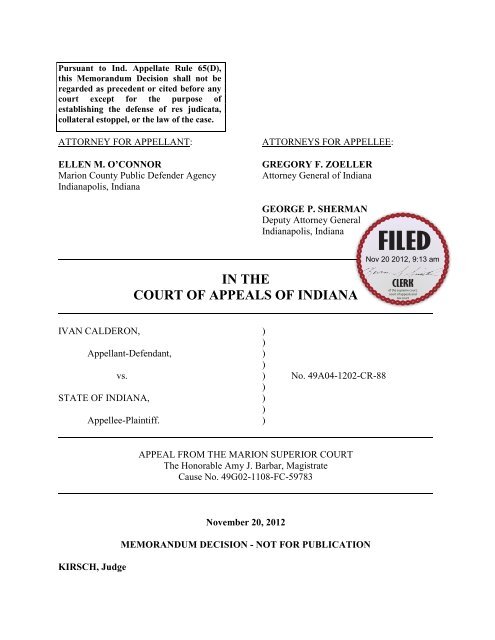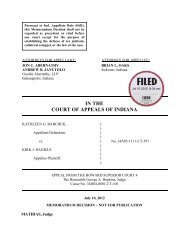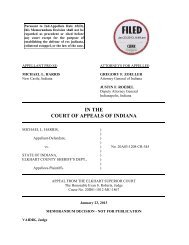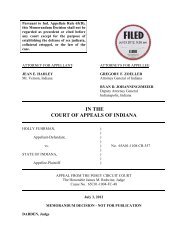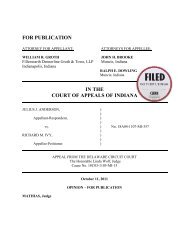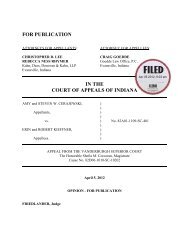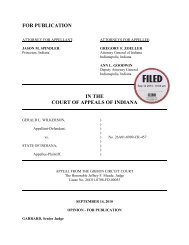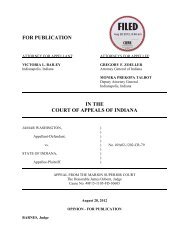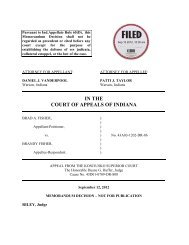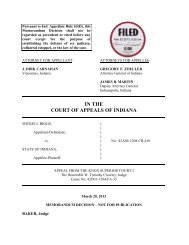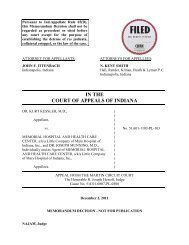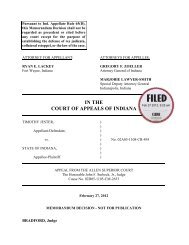Ivan Calderon v. State of Indiana
Ivan Calderon v. State of Indiana
Ivan Calderon v. State of Indiana
You also want an ePaper? Increase the reach of your titles
YUMPU automatically turns print PDFs into web optimized ePapers that Google loves.
Pursuant to Ind. Appellate Rule 65(D),<br />
this Memorandum Decision shall not be<br />
regarded as precedent or cited before any<br />
court except for the purpose <strong>of</strong><br />
establishing the defense <strong>of</strong> res judicata,<br />
collateral estoppel, or the law <strong>of</strong> the case.<br />
ATTORNEY FOR APPELLANT:<br />
ELLEN M. O’CONNOR<br />
Marion County Public Defender Agency<br />
<strong>Indiana</strong>polis, <strong>Indiana</strong><br />
ATTORNEYS FOR APPELLEE:<br />
GREGORY F. ZOELLER<br />
Attorney General <strong>of</strong> <strong>Indiana</strong><br />
GEORGE P. SHERMAN<br />
Deputy Attorney General<br />
<strong>Indiana</strong>polis, <strong>Indiana</strong><br />
IN THE<br />
COURT OF APPEALS OF INDIANA<br />
IVAN CALDERON, )<br />
)<br />
Appellant-Defendant, )<br />
)<br />
vs. ) No. 49A04-1202-CR-88<br />
)<br />
STATE OF INDIANA, )<br />
)<br />
Appellee-Plaintiff. )<br />
APPEAL FROM THE MARION SUPERIOR COURT<br />
The Honorable Amy J. Barbar, Magistrate<br />
Cause No. 49G02-1108-FC-59783<br />
KIRSCH, Judge<br />
November 20, 2012<br />
MEMORANDUM DECISION - NOT FOR PUBLICATION
<strong>Ivan</strong> <strong>Calderon</strong> (“<strong>Calderon</strong>”) was convicted after a bench trial <strong>of</strong> disarming a law<br />
enforcement <strong>of</strong>ficer 1 as a Class C felony, pointing a firearm 2 as a Class D felony, resisting<br />
law enforcement 3 as a Class D felony, possession <strong>of</strong> marijuana 4 as a Class A<br />
misdemeanor, and carrying a handgun without a license 5 as a Class A misdemeanor. He<br />
appeals, raising the following restated issue:<br />
whether the trial court committed<br />
fundamental error when it admitted evidence at trial that he contends was discovered in<br />
violation <strong>of</strong> the Fourth Amendment to the United <strong>State</strong>s Constitution because the <strong>of</strong>ficer<br />
lacked reasonable suspicion to stop and frisk him.<br />
We affirm.<br />
FACTS AND PROCEDURAL HISTORY<br />
On the evening <strong>of</strong> August 22, 2011, <strong>Indiana</strong>polis Metropolitan Police Officer Joel<br />
Kellar (“Officer Kellar”) was on routine patrol in <strong>Indiana</strong>polis, <strong>Indiana</strong> when he noticed a<br />
large group <strong>of</strong> people in the common area at the Greystone Apartments located at 5430<br />
Scarlet Drive. Officer Kellar parked his patrol car nearby and proceeded to walk around<br />
the area and observe what was going on. Officer Kellar patrolled the area frequently, and<br />
when he approached the large group <strong>of</strong> people, he looked to see if he recognized anyone<br />
from prior dealings. The group consisted <strong>of</strong> seven to eight people, all <strong>of</strong> whom were<br />
1 See Ind. Code § 35-44-3-3.5. We note that this section was repealed by Public Law 126-2012,<br />
section 53, effective July 1, 2012, and it can now be found at <strong>Indiana</strong> Code section 35-44.1-3-2.<br />
2 See Ind. Code § 35-47-4-3.<br />
3 See Ind. Code § 35-44-3-3. We note that this section was repealed by Public Law 126-2012,<br />
section 53, effective July 1, 2012, and it can now be found at <strong>Indiana</strong> Code section 35-44.1-3-1.<br />
4 See Ind. Code § 35-48-4-11.<br />
5 See Ind. Code §§ 35-47-2-1, 35-47-2-23.<br />
2
lack except for one male, later identified as <strong>Calderon</strong>.<br />
As Officer Kellar approached the group, he saw smoke and smelled the odor <strong>of</strong><br />
burnt marijuana. Officer Kellar asked the group how everyone was doing, which got<br />
everyone’s attention. <strong>Calderon</strong> stood out to Officer Kellar because the <strong>of</strong>ficer had never<br />
seen <strong>Calderon</strong> at the apartment complex before. When Officer Kellar made eye contact<br />
with <strong>Calderon</strong>, <strong>Calderon</strong>’s whole demeanor changed, and he put his head down and stuck<br />
his hands in his pockets. Because <strong>of</strong> problems with crime at the apartment complex,<br />
including break-ins, the apartment complex’s management has requested that <strong>of</strong>ficers<br />
look for individuals who were trespassing. Officer Kellar asked <strong>Calderon</strong> if he lived in<br />
the apartment complex. <strong>Calderon</strong> responded something to the effect <strong>of</strong>, “I’m going<br />
inside or I’m leaving now.” Tr. at 42. He then turned and walked toward Apartment B<br />
on the bottom floor <strong>of</strong> a nearby building.<br />
Officer Kellar was aware from prior<br />
investigations that a black male, a white female, and their child lived in the apartment to<br />
which <strong>Calderon</strong> had been walking, and he had never seen <strong>Calderon</strong> in that particular<br />
apartment.<br />
Officer Kellar told <strong>Calderon</strong> that he did not answer the <strong>of</strong>ficer’s question and<br />
asked <strong>Calderon</strong> to turn around and come back. <strong>Calderon</strong> walked back toward the <strong>of</strong>ficer.<br />
Officer Kellar reached his left hand toward <strong>Calderon</strong>’s shoulder so that Officer Kellar<br />
could perform a patdown search with his right hand. However, when Officer Kellar<br />
attempted to begin the patdown, <strong>Calderon</strong> immediately began running away from the<br />
<strong>of</strong>ficer. Officer Kellar grabbed <strong>Calderon</strong>’s shirt and was able to stay with him when<br />
<strong>Calderon</strong> ran between vehicles in the parking lot. Officer Kellar tried to put <strong>Calderon</strong> in<br />
3
custody, but <strong>Calderon</strong> started to fight with the <strong>of</strong>ficer. When Officer Kellar attempted to<br />
pin <strong>Calderon</strong> against a vehicle so that the <strong>of</strong>ficer could reach his radio and call for backup,<br />
he felt pressure on his weapon. Officer Kellar was unable to call for back-up because<br />
he had to step back from <strong>Calderon</strong> to make sure <strong>Calderon</strong> could not remove the <strong>of</strong>ficer’s<br />
weapon from its holster. <strong>Calderon</strong> again ran away from Officer Kellar, but the <strong>of</strong>ficer<br />
was able to catch <strong>Calderon</strong>.<br />
When Officer Kellar caught up to <strong>Calderon</strong>, <strong>Calderon</strong> threw the <strong>of</strong>ficer into a<br />
brick wall. The two continued to struggle with each other, and when Officer Kellar tried<br />
to take <strong>Calderon</strong> to the ground, <strong>Calderon</strong> pointed a handgun at the <strong>of</strong>ficer’s head. Officer<br />
Kellar immediately threw <strong>Calderon</strong> to the side to try to keep the handgun away from the<br />
<strong>of</strong>ficer. The struggle continued between the two, during which time, <strong>Calderon</strong> pointed<br />
the handgun at Officer Kellar three or four times. <strong>Calderon</strong> again ran away from the<br />
<strong>of</strong>ficer, but Officer Kellar caught him. At this point, <strong>Calderon</strong> raised his weapon again,<br />
and Officer Kellar reached for his own weapon while trying to prevent <strong>Calderon</strong> from<br />
pointing his gun at the <strong>of</strong>ficer. As soon as Officer Kellar removed his weapon from its<br />
holster, <strong>Calderon</strong> said, “Okay, Okay, I’m done. I’m done,” and he dropped his weapon.<br />
Id. at 60. After other <strong>of</strong>ficers arrived and <strong>Calderon</strong> was handcuffed, the <strong>of</strong>ficers found a<br />
handgun on the ground next to <strong>Calderon</strong> as well as three baggies <strong>of</strong> marijuana in his pants<br />
pocket.<br />
The <strong>State</strong> charged <strong>Calderon</strong> with disarming a law enforcement <strong>of</strong>ficer as a Class C<br />
felony, pointing a firearm as a Class D felony, criminal gang activity as a Class D felony,<br />
resisting law enforcement as a Class D felony, possession <strong>of</strong> marijuana as a Class A<br />
4
misdemeanor, and carrying a handgun without a license as a Class A misdemeanor. A<br />
bench trial was held, and <strong>Calderon</strong> did not object to the admission <strong>of</strong> the handgun and<br />
marijuana seized from him. At the conclusion <strong>of</strong> the trial, <strong>Calderon</strong> was found guilty <strong>of</strong><br />
disarming a law enforcement <strong>of</strong>ficer, pointing a firearm, resisting law enforcement,<br />
possession <strong>of</strong> marijuana, and carrying a handgun without a license, but was acquitted <strong>of</strong><br />
criminal gang activity. The trial court sentenced him to an aggregate sentence <strong>of</strong> threeand-one-half<br />
years with two years executed and one-and-one-half years on probation.<br />
<strong>Calderon</strong> now appeals.<br />
DISCUSSION AND DECISION<br />
The admission <strong>of</strong> evidence is within the sound discretion <strong>of</strong> the trial court, and we<br />
will reverse only on a showing <strong>of</strong> abuse <strong>of</strong> discretion. Boggs v. <strong>State</strong>, 928 N.E.2d 855,<br />
862 (Ind. Ct. App. 2010) (citing McClendon v. <strong>State</strong>, 910 N.E.2d 826, 832 (Ind. Ct. App.<br />
2009), trans. denied), trans. denied. An abuse <strong>of</strong> discretion occurs if the decision is<br />
clearly against the logic and effect <strong>of</strong> the facts and circumstances before the trial court.<br />
Id. However, <strong>Calderon</strong> failed to object to the admission <strong>of</strong> the evidence at trial, so he has<br />
waived any error in the admission <strong>of</strong> the evidence. Willis v. <strong>State</strong>, 907 N.E.2d 541, 545<br />
(Ind. Ct. App. 2009). A claim that has been waived by a defendant’s failure to raise a<br />
contemporaneous objection can be reviewed on appeal if the reviewing court determines<br />
that a fundamental error occurred. Brown v. <strong>State</strong>, 929 N.E.2d 204, 207 (Ind. 2010). The<br />
fundamental error exception is “extremely narrow, and applies only when the error<br />
constitutes a blatant violation <strong>of</strong> basic principles, the harm or potential for harm is<br />
substantial, and the resulting error denies the defendant fundamental due process.” Id.<br />
5
(citing Matthews v. <strong>State</strong>, 849 N.E.2d 578, 587 (Ind. 2006)). The error claimed must<br />
either “make a fair trial impossible” or constitute “clearly blatant violations <strong>of</strong> basic and<br />
elementary principles <strong>of</strong> due process.” Id. (citing Clark v. <strong>State</strong>, 915 N.E.2d 126, 131<br />
(Ind. 2009)). This exception is available only in “egregious circumstances.” Id. (citing<br />
Brown v. <strong>State</strong>, 799 N.E.2d 1064, 1068 (Ind. 2003)).<br />
<strong>Calderon</strong> argues that the trial court erred when it allowed the handgun and<br />
marijuana seized from him to be admitted into evidence. He contends that the evidence<br />
was discovered in violation <strong>of</strong> the Fourth Amendment to the United <strong>State</strong>s Constitution<br />
because Officer Kellar lacked reasonable suspicion to stop and frisk him. <strong>Calderon</strong><br />
claims that this is because Officer Kellar did not have any evidence <strong>of</strong> illegality when he<br />
stopped <strong>Calderon</strong>, and because the stop was not justified, it was fundamental error to<br />
admit the evidence seized as a result <strong>of</strong> the stop.<br />
The Fourth Amendment protects persons from unreasonable search and seizure,<br />
and this protection has been extended to the states through the Fourteenth Amendment.<br />
U.S. Const. amend. IV; Boggs, 928 N.E.2d at 863. Generally, a search warrant is a<br />
prerequisite to a constitutionally proper search and seizure. Id. (citing Halsema v. <strong>State</strong>,<br />
823 N.E.2d 668, 676 (Ind. 2005)). When a search or seizure is conducted without a<br />
warrant, the <strong>State</strong> bears the burden <strong>of</strong> proving that an exception to the warrant<br />
requirement existed at the time <strong>of</strong> the search or seizure. Id.<br />
The United <strong>State</strong>s Supreme Court established one such exception in Terry v. Ohio,<br />
392 U.S. 1 (1968), which held that a police <strong>of</strong>ficer may briefly detain a person for<br />
investigatory purposes without a warrant or probable cause, if, based on specific and<br />
6
articulable facts together with reasonable inferences from those facts, an ordinarily<br />
prudent person would reasonably suspect that criminal activity was afoot. Howard v.<br />
<strong>State</strong>, 862 N.E.2d 1208, 1210 (Ind. Ct. App. 2007). Reasonable suspicion is determined<br />
on a case-by-case basis by looking at the totality <strong>of</strong> the circumstances. Id. In addition to<br />
detainment, Terry permits a police <strong>of</strong>ficer to conduct a limited search <strong>of</strong> the individual’s<br />
outer clothing for weapons if the <strong>of</strong>ficer reasonably believes the individual is armed and<br />
dangerous. Id.<br />
In the present case, the evidence showed that, at the time that Officer Kellar<br />
stopped <strong>Calderon</strong>, the <strong>of</strong>ficer was aware that there had been reports <strong>of</strong> criminal activity at<br />
the apartment complex, including break-ins <strong>of</strong> uninhabited apartments and individuals<br />
trespassing on the property. He also observed smoke and smelled the odor <strong>of</strong> marijuana<br />
coming from the area where the group <strong>of</strong> people, including <strong>Calderon</strong>, was standing when<br />
Officer Kellar approached. Officer Kellar had a familiarity with the area, and he did not<br />
recognize <strong>Calderon</strong> and had never seen him at the apartment complex before. When<br />
Officer Kellar made eye contact with <strong>Calderon</strong>, <strong>Calderon</strong> acted evasively, looking down<br />
and sticking his hands in his pockets. <strong>Calderon</strong> then began to walk away in the direction<br />
<strong>of</strong> an apartment where Officer Kellar knew the occupants and did not believe that<br />
<strong>Calderon</strong> lived. Based on the totality <strong>of</strong> the circumstances, reasonable suspicion existed<br />
for Officer Kellar to stop <strong>Calderon</strong>. We therefore conclude that <strong>Calderon</strong> has failed to<br />
demonstrate that the trial court committed fundamental error when it admitted the<br />
evidence seized from <strong>Calderon</strong>. Affirmed.<br />
NAJAM, J., and MAY, J., concur.<br />
7


